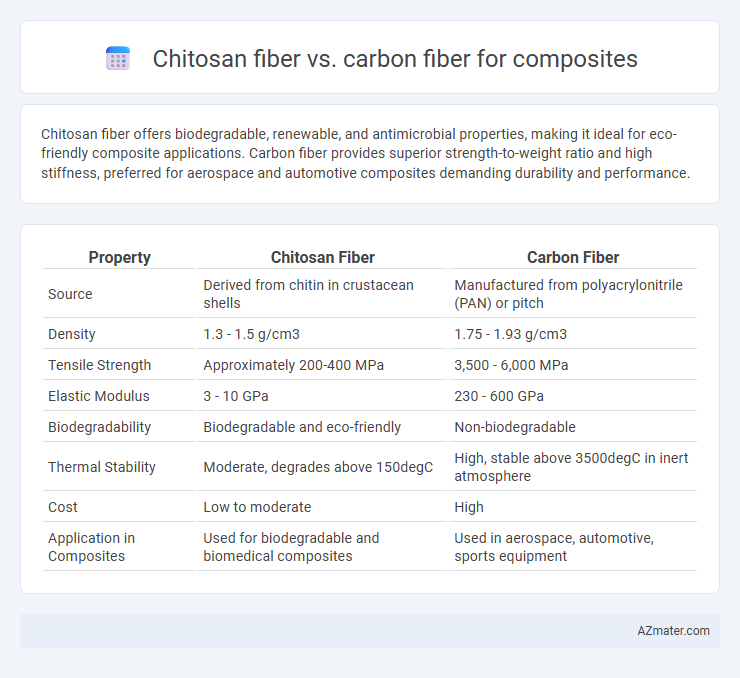Chitosan fiber offers biodegradable, renewable, and antimicrobial properties, making it ideal for eco-friendly composite applications. Carbon fiber provides superior strength-to-weight ratio and high stiffness, preferred for aerospace and automotive composites demanding durability and performance.
Table of Comparison
| Property | Chitosan Fiber | Carbon Fiber |
|---|---|---|
| Source | Derived from chitin in crustacean shells | Manufactured from polyacrylonitrile (PAN) or pitch |
| Density | 1.3 - 1.5 g/cm3 | 1.75 - 1.93 g/cm3 |
| Tensile Strength | Approximately 200-400 MPa | 3,500 - 6,000 MPa |
| Elastic Modulus | 3 - 10 GPa | 230 - 600 GPa |
| Biodegradability | Biodegradable and eco-friendly | Non-biodegradable |
| Thermal Stability | Moderate, degrades above 150degC | High, stable above 3500degC in inert atmosphere |
| Cost | Low to moderate | High |
| Application in Composites | Used for biodegradable and biomedical composites | Used in aerospace, automotive, sports equipment |
Introduction to Chitosan and Carbon Fibers
Chitosan fiber, derived from chitin in crustacean shells, offers biodegradability, biocompatibility, and antimicrobial properties, making it suitable for sustainable composite applications. Carbon fiber, produced from polyacrylonitrile (PAN) or pitch, is renowned for its exceptional strength-to-weight ratio, high stiffness, and thermal stability, dominating advanced composite materials in aerospace and automotive industries. Understanding the distinct chemical structures and mechanical profiles of chitosan and carbon fibers is essential for optimizing composite performance across diverse engineering fields.
Material Sources and Production Processes
Chitosan fiber, derived from chitin found in crustacean shells, offers a renewable and biodegradable alternative to carbon fiber, which is produced from polyacrylonitrile (PAN) or petroleum-based precursors through energy-intensive processes. The production of chitosan fiber involves chemical deacetylation followed by fiber spinning techniques that emphasize sustainability and lower environmental impact, while carbon fiber manufacturing relies on high-temperature carbonization and oxidation treatments requiring significant energy consumption. Material sourcing for chitosan fiber emphasizes waste valorization from marine resources, contrasting with the fossil fuel dependency inherent in carbon fiber precursor materials.
Mechanical Properties Comparison
Chitosan fiber exhibits biodegradability and moderate tensile strength of approximately 300-400 MPa, making it suitable for lightweight, eco-friendly composites but limited in high-stress applications. Carbon fiber, with tensile strength exceeding 3,500 MPa and a Young's modulus of around 230-600 GPa, offers superior stiffness and durability, ideal for aerospace and automotive composites. The mechanical properties comparison highlights carbon fiber's dominance in strength and rigidity, while chitosan fiber provides sustainability and better impact absorption in bio-composites.
Environmental Impact and Sustainability
Chitosan fiber, derived from renewable sources like shrimp shells, offers biodegradability and low environmental impact compared to carbon fiber, which relies on energy-intensive production and non-renewable fossil fuels. The biodegradability of chitosan fiber ensures reduced landfill waste, promoting circular economy principles for composites. Carbon fiber composites, while high-performing, present recycling challenges and higher carbon footprints, making chitosan fiber a more sustainable option for eco-friendly composite materials.
Cost Analysis and Economic Viability
Chitosan fiber offers a cost-effective alternative to carbon fiber in composite manufacturing, as it utilizes abundant biopolymer sources like crustacean shells, significantly reducing raw material expenses. While carbon fiber provides superior mechanical strength and performance, its high production costs and energy-intensive processes limit economic viability in large-scale applications. Chitosan fiber composites demonstrate promising potential for sustainable and affordable materials in industries prioritizing cost-efficiency over peak structural performance.
Biocompatibility and Biomedical Applications
Chitosan fiber exhibits superior biocompatibility and biodegradability compared to carbon fiber, making it highly suitable for biomedical applications such as tissue engineering and drug delivery systems. Carbon fiber offers exceptional mechanical strength and thermal stability but lacks inherent biocompatibility, often requiring surface modifications for safe use in implants and prosthetics. The integration of chitosan fiber in composites enables enhanced cell adhesion and antimicrobial properties, critical for regenerative medicine and wound healing applications.
Performance in Composite Structures
Chitosan fiber exhibits biocompatibility and biodegradability, making it ideal for environmentally friendly composite structures but offers lower mechanical strength and stiffness compared to carbon fiber. Carbon fiber provides superior tensile strength, high stiffness, and excellent fatigue resistance, significantly enhancing the performance of advanced composite materials used in aerospace, automotive, and sporting applications. The choice between chitosan and carbon fibers depends on the specific performance requirements, with carbon fiber favored for high-load structural applications and chitosan fiber suited for lightweight, sustainable composites.
Durability and Lifespan of Composites
Chitosan fiber composites exhibit moderate durability with excellent biodegradability but generally have a shorter lifespan compared to carbon fiber composites, which offer superior strength, stiffness, and resistance to environmental degradation. Carbon fiber composites maintain structural integrity under high stress and harsh conditions, resulting in extended service life ideal for aerospace and automotive applications. Despite chitosan's eco-friendly nature, carbon fiber remains the preferred choice for long-term durability and high-performance composite solutions.
Market Trends and Industry Adoption
Chitosan fiber is gaining traction in the composite market due to its biodegradability and renewable sourcing, appealing to industries prioritizing sustainability and eco-friendly materials. Carbon fiber maintains dominance in aerospace and automotive sectors with its superior strength-to-weight ratio, established performance, and extensive supply chains. Emerging policies promoting green materials are accelerating the adoption of chitosan fiber composites, while carbon fiber continues to benefit from ongoing innovations in manufacturing efficiency and cost reduction.
Future Perspectives and Research Directions
Chitosan fiber offers promising biodegradability and biocompatibility for sustainable composite applications, while carbon fiber excels in high strength-to-weight ratio and electrical conductivity. Future research is directed towards enhancing chitosan fiber's mechanical properties and integrating it with hybrid composites to expand its usability in automotive and aerospace sectors. Advances in nanotechnology and surface modification techniques aim to improve interfacial bonding between chitosan fibers and polymer matrices, bridging the performance gap with carbon fibers.

Infographic: Chitosan fiber vs Carbon fiber for Composite
 azmater.com
azmater.com